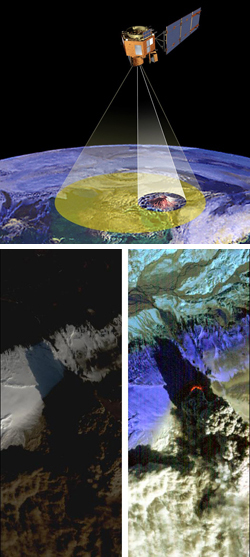
Bottom image: EO-1 Hyperion imagery of Iceland’s Eyafallajökull volcano, left (visible) right (false-color thermal enhancement).
Researchers in JPL’s Artificial Intelligence Group have developed a new scheduling algorithm that has increased the Earth Observing Mission 1 (EO-1) satellite’s productivity. This new algorithm allows the EO-1 satellite to take up to 40 percent more images than it has been able to in the past.
These images (or “scenes”) taken by EO-1 enable key measurements in ecosystem health, crop conditions and invasive species, all of which are important aspects of monitoring Earth’s changing environment.
The EO-1 satellite was launched by NASA in 2000 and carries three instruments – Advanced Land Imager (ALI), a multispectral imager; Hyperion, a hyperspectral imager; and the Atmospheric Corrector (AC). EO-1 was developed by NASA’s Goddard Space Flight Center, Greenbelt, MD, as part of the JPL-managed New Millennium Program to validate new spacecraft technologies.
With a wide range of potential image targets and many operational constraints, mission planners found that scheduling imaging activities each week was a challenging, knowledge-intensive task.
Continuous Improvement
In 2004, EO-1 was in its extended mission phase and continuous improvements to the ground-based and onboard software had increased the number of possible images from tens per week to 100 per week. This increase in images was made possible by improvements to EO-1’s software (called “R4”). But in 2008, Steve Chien and the Artificial Intelligence Group at JPL decided that they could make additional improvements to the software. The research team set out to develop an improved scheduling algorithm that would increase flexibility (enabling last-minute changes to the schedule) and acquire more scenes per week (increasing mission productivity) than was possible with R4.
To do this, Chien and his team had to deal with numerous operational and hardware constraints:
- Activity Timing: instrument, spacecraft maneuvers, downlinks and use of the onboard recorder all must be carefully synchronized. Certain activities cannot occur at the same time, and other activities must not occur too close to other activities.
- Data Storage: the onboard solid-state recorder has limitations on both the total amount of storage and the number of files it could store.
- Priority: high-priority scenes must be preferred over lower priority scenes. EO-1 is oversubscribed severalfold (e.g. there are many times more scene requests than can be fulfilled in any week).
- Maneuvering: for each scene, the spacecraft must be slewed to the spacecraft’s field of view and then slewed to the next appropriate orientation within rate, pointing, momentum management and settling constraints.
- Thermal: too many consecutive scenes overheats the instruments while they are active and imaging, placing a restriction on consecutive imaging.
Given these constraints, Chien’s team at JPL first looked at data from the previous years of operations, improving modeling of the timing, thermal management and maneuver construction. “Modeling these operations constraints was a tremendous challenge involving significant advances in modeling and scheduling technology,” said Chien, lead for the project. After these new constraints were analyzed and modeled, the team conducted flight tests with the EO-1 spacecraft to validate a new scheduling and operations approach.
Getting Priorities Straight
In June 2009, the new R5 algorithm replaced the existing R4 algorithm, making EO-1’s scheduling software smarter, more flexible and more productive. R5 is now able to compile user image requests and plan them out based on orbital location and priority, looking at several thousand possible scene combinations over a week’s schedule. It then decides how to best combine scenes into a sequence of single, double or triple images and plots out the best plan of action – all within about 15 minutes. Both the earlier R4 and the new R5 software work closely with the Autonomous Sciencecraft (ASE) Software onboard the EO-1 spacecraft, which enables the spacecraft to analyze imagery onboard to detect and respond to key science events such as volcanic activity, flooding, forest fires or cryosphere events.
In a paper presented at the 20th International Conference on Automated Planning and Scheduling (ICAPS) in Toronto, Canada, Chien and his co-authors describe the R5 software as a significant step forward in automated scheduling for spacecraft operations. The paper has won the “Best Application Paper” – a prestigious honor that has only been awarded several times over the life of the ICAPS conference series. The R5 algorithm has increased the number of images acquired by EO-1 from 110 per week to 170 per week, creating additional value in the millions of dollars. Thanks to the new R5 algorithm, which increases flexibility and productivity, EO-1 can now participate in more concurrent science campaigns such as the one to monitor the Eyafallajökull volcano in Iceland.
Future Planning
The R5 algorithm represents just one of a series of new spacecraft automation and autonomy systems being developed for future space missions for NASA and other institutions. Onboard mission planning (currently flying onboard the EO-1 mission) as well as event detection, data summarization and prioritization algorithms are being developed. These new algorithms could support future missions to comets, surface rovers, Europa and a Titan Aerobot. Such systems, based on the building blocks of R5, would enable a spacecraft to better search for interesting science phenomena and decide for itself how to map and explore more efficiently.
Links
- JPL Artificial Intelligence
- Autonomous Sciencecraft Experiment
- EO-1 Website
- New Millennium Program
- Recent imagery of the Eyafallajökull volcano in Iceland by EO-1: